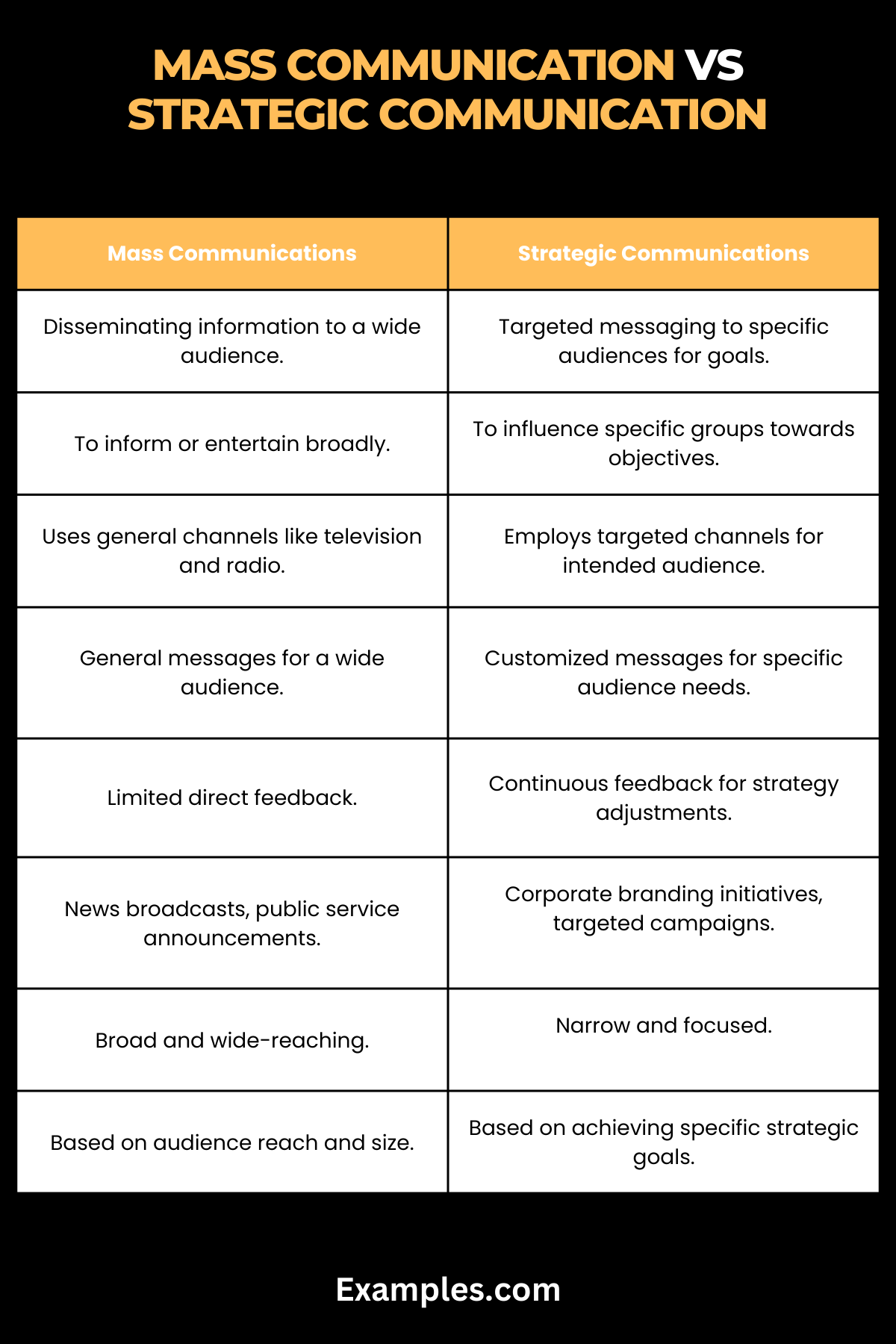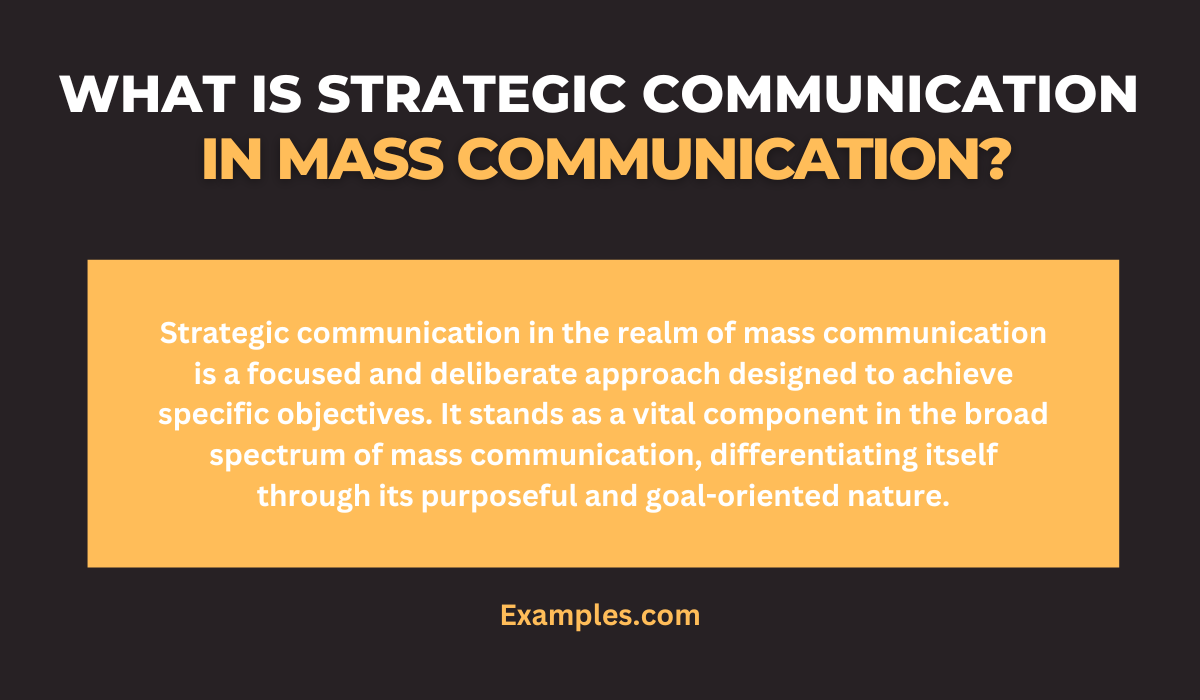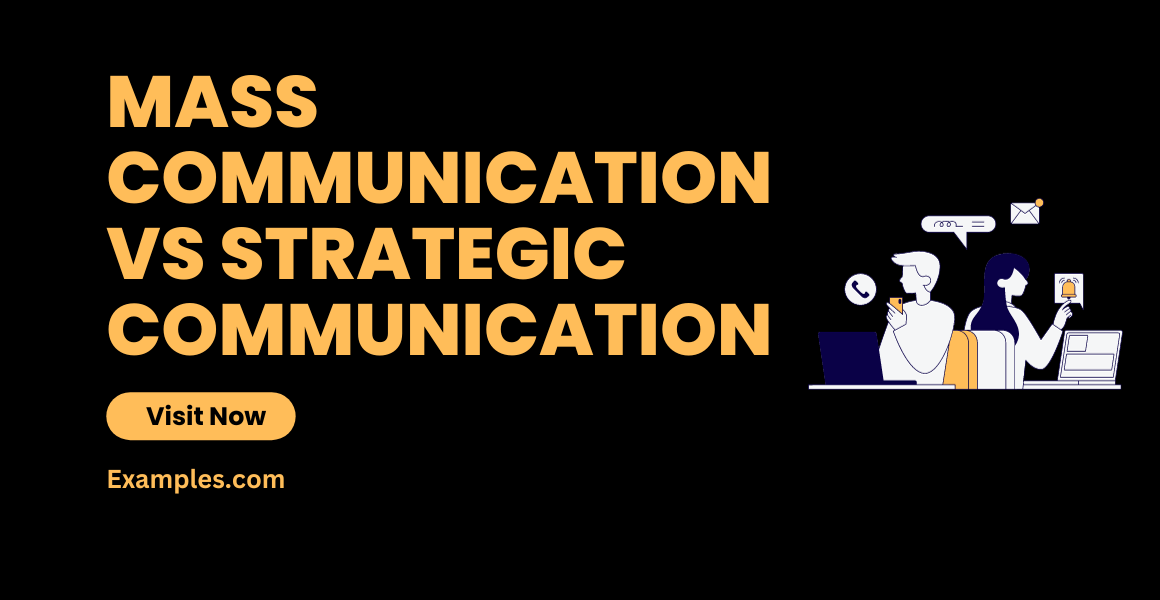Mass Communication vs Strategic Communication – Examples
In today’s interconnected world, understanding the nuances between Mass Communication and Strategic Communication is essential. While both play pivotal roles in disseminating information and shaping perceptions, they differ significantly in their approaches and objectives. Mass Communication broadly broadcasts information to a wide audience, focusing on general public engagement. In contrast, Strategic Communication involves more targeted, purpose-driven messaging aimed at achieving specific goals. This comparison delves into their distinct methodologies, impacts, and roles in the evolving landscape of media and communication.
What is the Difference Between Mass Communications and Strategic Communications?
The fields of mass communications and strategic communications, while related, differ significantly in several key aspects. Below is an expanded comparison presented in a table format, covering more aspects to highlight their distinct characteristics:

| Aspect | Mass Communications | Strategic Communications |
|---|---|---|
| Definition | Involves disseminating information broadly to a wide, undifferentiated audience. | Focused on delivering targeted messages to specific audiences to achieve strategic goals. |
| Primary Objective | Aims to inform or entertain a general audience. | Seeks to influence, motivate, or engage a particular group to achieve specific objectives. |
| Approach | Employs a one-to-many communication model, using channels like television, radio, and print media. | Utilizes a targeted approach, selecting specific channels that effectively reach the intended audience. |
| Message Customization | Messages are generally crafted to appeal to broad, diverse audiences. | Messages are highly customized, tailored to resonate with the specific interests and needs of the target audience. |
| Feedback and Analysis | Often relies on general audience ratings, surveys, and broad market research. | Involves continuous feedback mechanisms and adjustments based on audience engagement and response. |
| Key Examples | News broadcasts, public service announcements, general advertising campaigns. | Corporate branding initiatives, targeted public health campaigns, political communication strategies. |
| Scope and Scale | Broad in scope, aiming for maximum reach and audience engagement. | Narrow and focused, targeting specific demographics or audience segments for precise impact. |
| Outcome Measurement | Success is typically measured by audience reach, viewership, or readership size. | Success is gauged by the effectiveness in achieving specific objectives, like behavioral change or awareness. |
| Content Style | Content tends to be more general, covering a wide array of topics to cater to diverse interests. | Content is often issue-specific, detailed, and aligned with the strategic goals of the campaign or initiative. |
| Audience Interaction | Interaction with the audience is generally limited and less direct. | Encourages direct engagement and interaction with the target audience for feedback and better impact. |
| Tactical Execution | Execution is more about widespread dissemination and coverage. | Focuses on strategically planned execution with a clear roadmap and specific tactics aligned with goals. |
| Resource Allocation | Resources are distributed broadly to cover a wide range of media outlets and platforms. | Resources are allocated specifically to target chosen media platforms and communication channels. |
| Timeframe and Flexibility | Often operates on a fixed schedule with long-term planning for regular broadcasts or publications. | More flexible, adapting to changing scenarios and audience dynamics, often involving shorter, campaign-based timeframes. |
| Impact Assessment | Impact is assessed based on general public perception and brand recognition. | Impact is closely monitored against key performance indicators (KPIs) and specific campaign objectives. |
This detailed comparison underscores the distinct approaches, goals, and methodologies between mass communications and strategic communications. While mass communications cast a wide net to reach as many people as possible, strategic communications are meticulously planned and executed to influence and engage specific audience segments, reflecting their divergent roles in the field of communication
What is Strategic Communication in Mass Communication?
Strategic communication is a key facet of mass communication, characterized by its focused approach and goal-oriented strategies. Unlike broad-based mass communication, which aims to disseminate information to a large audience, strategic communication is about crafting and delivering messages to specific segments with a clear purpose in mind.

Definition and Purpose
Strategic communication within mass communication refers to the intentional and systematic use of communication channels and techniques to convey a targeted message to a specific audience. It’s designed to achieve particular outcomes, such as influencing public opinion, promoting a brand, or advocating for a cause.
Characteristics of Strategic Communication
- Targeted Messaging: Strategic communication in mass communication emphasizes reaching specific audiences with messages tailored to their interests and needs, as opposed to broadcasting general information.
- Objective-driven: It is defined by clear objectives, whether influencing behavior, shaping perceptions, or encouraging specific actions, making it a critical component of effective mass communication.
Implementation in Different Sectors
- Public Relations: Utilized in public relations, strategic communication aims to shape and maintain the public image of an entity or individual.
- Marketing and Advertising: In marketing and advertising, it focuses on persuading and influencing consumer behavior towards a product or service.
The Role of Strategic Communication in Mass Communication
Strategic communication plays an integral role in the broader field of mass communication by adding precision and intentionality to the way messages are crafted and disseminated. It ensures that the communication not only reaches but also resonates with the target audience, leading to the desired impact or action.
Understanding the distinction between Mass Communications and Strategic Communications is pivotal for effective communication strategies. While Mass Communications cast a wide net to inform or entertain a large audience, Strategic Communications focus on targeted, goal-oriented messaging. Recognizing these differences is crucial for anyone looking to craft impactful messages and engage with audiences in the ever-evolving landscape of media and communication.



